Study on the Impact Pressure of Swirling-Round Supercritical CO2 Jet Flow and Its Influencing Factors
Abstract
:1. Introduction
2. Numerical Simulation
2.1. Geometric Model and Meshing
2.2. Governing Equations
2.2.1. Continuity Equation
2.2.2. Momentum Conservation Equation
2.2.3. Energy Conservation Equation
2.2.4. RNG k-ε Equations
2.2.5. Boundary Conditions
Inlet Boundary
Outlet Boundary
Wall Boundary Conditions
- (i)
- Wall boundary of u
- (ii)
- wall boundary of T
- (iii)
- wall boundary of k and ε
2.3. Structure Parameter Setting
2.4. Simulation Procedure
3. Results and Discussion
3.1. Flow Field Simulation
3.2. Parameter Analysis
3.2.1. Pressure Drop of the Nozzle
3.2.2. Confining Pressure
3.2.3. Jet Flow Temperature
3.2.4. Jetting Distance
3.2.5. Diameter of the Nozzle’s Central Hole
3.2.6. Grooving Area of the Nozzle
4. Conclusions
Author Contributions
Funding
Acknowledgments
Conflicts of Interest
References
- Dargahi-Zaboli, M.; Sahraei, E.; Pourabbas, B. Hydrophobic silica nanoparticle-stabilized invert emulsion as drilling fluid for deep drilling. Petrol. Sci. 2017, 14, 105–115. [Google Scholar] [CrossRef] [Green Version]
- Xu, Z.; Song, X.; Li, G.; Wu, K.; Pang, Z.; Zhu, Z. Development of a transient non-isothermal two-phase flow model for gas kick simulation in HTHP deep well drilling. Appl. Therm. Eng. 2018, 141, 1055–1069. [Google Scholar] [CrossRef]
- Yin, H.; Si, M.; Qian, L.; Jiang, H.; Dai, L. Mechanism and prevention method of drill string uplift during shut-in after overflow in an ultra-deep well. Petrol. Explor. Dev. 2018, 45, 1139–1145. [Google Scholar] [CrossRef]
- Dougherty, P.S.; Pudjoprawoto, R.; Higgs, C.F., III. Bit cutter-on-rock tribometry: Analyzing friction and rate-of-penetration for deep well drilling substrates. Tribol. Int. 2014, 77, 178–185. [Google Scholar] [CrossRef]
- Ni, H.J.; Wang, R.H.; Zhang, Y.Q. Numerical simulation study on rock breaking mechanism and process under high pressure water jet. Appl. Math. Mech. Engl. Ed. 2005, 26, 1595–1604. [Google Scholar] [CrossRef]
- Li, G.; Huang, Z.; Tian, S.; Shen, Z. Research and application of water jet technology in well completion and stimulation in China. Petrol. Sci. 2010, 7, 239–244. [Google Scholar] [CrossRef] [Green Version]
- Rozell, D.J.; Reaven, S.J. Water pollution risk associated with natural gas extraction from the Marcellus Shale. Risk Anal. 2012, 32, 1382–1393. [Google Scholar] [CrossRef]
- Clark, C.E.; Horner, R.M.; Harto, C.B. Life cycle water consumption for shale gas and conventional natural gas. Environ. Sci. Technol. 2013, 47, 11829–11836. [Google Scholar] [CrossRef]
- Hyman, J.D.; Jiménez-Martínez, J.; Viswanathan, H.S.; Carey, J.W.; Porter, M.L.; Rougier, E.; Karra, S.; Kang, Q.; Frash, L.; Chen, L.; et al. Understanding hydraulic fracturing: A multi-scale problem. Philos. Trans. R. Soc. A 2016, 374, 20150426. [Google Scholar] [CrossRef]
- Zhao, J.; Zhang, G.; Xu, Y.; Lin, A.; Zhao, J.; Yang, D. Enhancing rate of penetration in a tight formation with high-pressure water jet (HPWJ) via a downhole pressurized drilling tool. J. Petrol. Sci. Eng. 2019, 174, 1194–1207. [Google Scholar] [CrossRef]
- Ali, M.; Jarni, H.H.; Aftab, A.; Ismail, A.R.; Saady, N.M.C.; Sahito, M.F.; Keshavarz, A.; Iglauer, S.; Sarmadivaleh, M. Nanomaterial-based drilling fluids for exploitation of unconventional reservoirs: A review. Energies 2020, 13, 3417. [Google Scholar] [CrossRef]
- Aftab, A.; Ali, M.; Arif, M.; Panhwar, S.; Saady, N.M.C.; Al-Khdheeawi, E.A.; Mahmoud, O.; Ismail, A.R.; Keshavarz, A.; Iglauer, S. Influence of tailor-made TiO2/API bentonite nanocomposite on drilling mud performance: Towards enhanced drilling operations. Appl. Clay Sci. 2020, 199, 105862. [Google Scholar] [CrossRef]
- LI, G.; Shen, Z. Advances in researches and applications of water jet theory in petroleum engineering. Petrol. Explor. Dev. 2005, 32, 96–99. [Google Scholar]
- Buckman, W.G., Sr.; Dotson, T.L.; Mcdaniels, M.D.; Bell, W.S. Nozzle for Jet Drilling and Associated Method. U.S. Patent 6,668,948, 30 December 2003. [Google Scholar]
- Ma, D.; Li, G.; Zhang, X.; Huang, Z. Experimental study on rock breaking by a combined round straight jet with a swirling jet nozzle. At. Spray 2011, 21, 645–653. [Google Scholar] [CrossRef]
- Tian, S.; Zhang, Q.; Li, G.; Chi, H.; Wang, H.; Peng, K.; Li, Z. Rock-Breaking Characteristics for the Combined Swirling and Straight Supercritical Carbon Dioxide Jet under Ambient Pressure. At. Spray 2016, 26, 659–671. [Google Scholar] [CrossRef]
- Kolle, J.J. Coiled-tubing drilling with supercritical carbon dioxide. In Proceedings of the SPE/CIM International Conference on Horizontal Well Technology, SPE-65534-MS, Calgary, AB, Canada, 6–8 November 2000. [Google Scholar]
- Gupta, A.P.; Gupta, A.; Langlinais, J. Feasibility of supercritical carbon dioxide as a drilling fluid for deep underbalanced drilling operation. In Proceedings of the SPE Annual Technical Conference and Exhibition, SPE-96992-MS, Dallas, TX, USA, 9–12 October 2005. [Google Scholar]
- Shen, Z.; Wang, H.; Li, G. Feasibility analysis of coiled tubing drilling with supercritical carbon dioxide. Petrol. Explor. Dev. 2010, 37, 743–747. [Google Scholar] [CrossRef]
- Shen, Z.; Wang, H.; Li, G. Numerical simulation of the cutting-carrying ability of supercritical carbon dioxide drilling at horizontal section. Petrol. Explor. Dev. 2011, 38, 233–236. [Google Scholar] [CrossRef]
- Du, Y.K.; Wang, R.H.; Ni, H.J.; Li, M.K.; Song, W.Q.; Song, H.F. Determination of rock-breaking performance of high-pressure supercritical carbon dioxide jet. J. Hydrodyn. 2012, 24, 554–560. [Google Scholar] [CrossRef]
- Wang, H.; Li, G.; Shen, Z.; Tian, S.; Sun, B.; He, Z.; Lu, P. Experiment on rock breaking with supercritical carbon dioxide jet. J. Petrol. Sci. Eng. 2015, 127, 305–310. [Google Scholar] [CrossRef]
- Long, X.; Liu, Q.; Ruan, X.; Kang, Y.; Lyu, Q. Numerical investigation of the flow of supercritical carbon dioxide injected into the bottom hole during drilling with special emphasis on the real gas effects. J. Nat. Gas Sci. Eng. 2016, 34, 1044–1053. [Google Scholar] [CrossRef]
- Zhou, Z.; Lu, Y.; Tang, J.; Zhang, X.; Li, Q. Numerical simulation of supercritical carbon dioxide jet at well bottom. Appl. Therm. Eng. 2017, 121, 210–217. [Google Scholar] [CrossRef]
- Erkey, C.; Madras, G.; Orejuela, M.; Akgerman, A. Supercritical carbon dioxide extraction of organics from soil. Environ. Sci. Technol. 1993, 27, 1225–1231. [Google Scholar] [CrossRef]
- Ali, M.; Sahito, M.F.; Jha, N.K.; Memon, S.; Keshavarz, A.; Iglauer, S.; Saeedi, A.; Sarmadivaleh, M. Effect of nanofluid on CO2-wettability reversal of sandstone formation; implications for CO2 geo-storage. J. Colloid Interface Sci. 2020, 559, 304–312. [Google Scholar] [CrossRef] [PubMed]
- Ajayi, T.; Gomes, J.S.; Bera, A. A review of CO2 storage in geological formations emphasizing modeling, monitoring and capacity estimation approaches. Petrol. Sci. 2019, 16, 1028–1063. [Google Scholar] [CrossRef] [Green Version]
- Sayyafzadeh, M.; Keshavarz, A.; Alias, A.R.M.; Dong, K.A.; Manser, M. Investigation of varying-composition gas injection for coalbed methane recovery enhancement: A simulation-based study. J. Nat. Gas Sci. Eng. 2015, 27, 1205–1212. [Google Scholar] [CrossRef]
- Mazzotti, M.; Pini, R.; Storti, G. Enhanced coalbed methane recovery. J. Supercrit. Fluid 2009, 47, 619–627. [Google Scholar] [CrossRef]
- Wang, H.; Li, G.; Shen, Z. A feasibility analysis on shale gas exploitation with supercritical carbon dioxide. Energy Sources Part A 2012, 34, 1426–1435. [Google Scholar] [CrossRef]
- Tang, X.; Ripepi, N. High pressure supercritical carbon dioxide adsorption in coal: Adsorption model and thermodynamic characteristics. J. CO2 Util. 2017, 18, 189–197. [Google Scholar] [CrossRef] [Green Version]
- Wang, T.; Tian, S.; Li, G.; Sheng, M. Selective adsorption of supercritical carbon dioxide and methane binary mixture in shale kerogen nanopores. J. Nat. Gas Sci. Eng. 2018, 50, 181–188. [Google Scholar] [CrossRef]
- Keshavarz, A.; Sakurovs, R.; Grigore, M.; Sayyafzadeh, M. Effect of maceral composition and coal rank on gas diffusion in Australian coals. Int. J. Coal Geol. 2017, 173, 65–75. [Google Scholar] [CrossRef]
- Sayyafzadeh, M.; Keshavarz, A. Optimisation of gas mixture injection for enhanced coalbed methane recovery using a parallel genetic algorithm. J. Nat. Gas Sci. Eng. 2016, 33, 942–953. [Google Scholar] [CrossRef]
- Akhondzadeh, H.; Keshavarz, A.; Sayyafzadeh, M.; Kalantariasl, A. Investigating the relative impact of key reservoir parameters on performance of coalbed methane reservoirs by an efficient statistical approach. J. Nat. Gas Sci. Eng. 2018, 53, 416–428. [Google Scholar] [CrossRef]
- Kolle, J.J.; Marvin, M.H. Jet Assisted Drilling with Supercritical Carbon Dioxide; Tempress Technologies Inc.: Renton, WA, USA, 2000. [Google Scholar]
- He, Z.; Li, G.; Wang, H.; Shen, Z.; Tian, S.; Lu, P.; Guo, B. Numerical simulation of the abrasive supercritical carbon dioxide jet: The flow field and the influencing factors. J. Hydrodyn. 2016, 28, 238–246. [Google Scholar] [CrossRef]
- Cheng, Y.; Li, G.; Wang, H.; Shen, Z.; Fan, X. Feasibility analysis on coiled-tubing jet fracturing with supercritical CO2. Oil Drill. Prod. Technol. 2013, 35, 73–77. (In Chinese) [Google Scholar]
- Tian, S.; Liu, Q.; Sheng, M.; Li, G.; Wang, H. Mechanisms of rock breaking by swirling-round SC-CO2 jet. Sci. China Phys. Chem. 2017, 47, 78–87. (In Chinese) [Google Scholar]
- Fluent, A. ANSYS Fluent 12.0 Theory Guide; ANSYS Inc.: Canonsburg, PA, USA, 2009. [Google Scholar]
- Jayatillaka, C. The Influence of Prandtl Number and Surface Roughness on the Resistance of the Laminar Sublayer to Momentum and Heat Transfer. Ph.D. Thesis, Imperial College London, London, UK, 1969. [Google Scholar]
- Le Roux, J.P. An integrated law of the wall for hydrodynamically transitional flow over plane beds. Sediment. Geol. 2004, 163, 311–321. [Google Scholar] [CrossRef]
- Fu, B.W.; Zhang, S.; Liu, S.H. Effect of the structure of backward orifices on the jet performance of self-propelled nozzles. Petrol. Sci. 2020. [Google Scholar] [CrossRef]
- Mathur, S.R.; Murthy, J.Y. A pressure-based method for unstructured meshes. Numer. Heat Transf. Part B Fundam. 1997, 31, 195–215. [Google Scholar] [CrossRef]


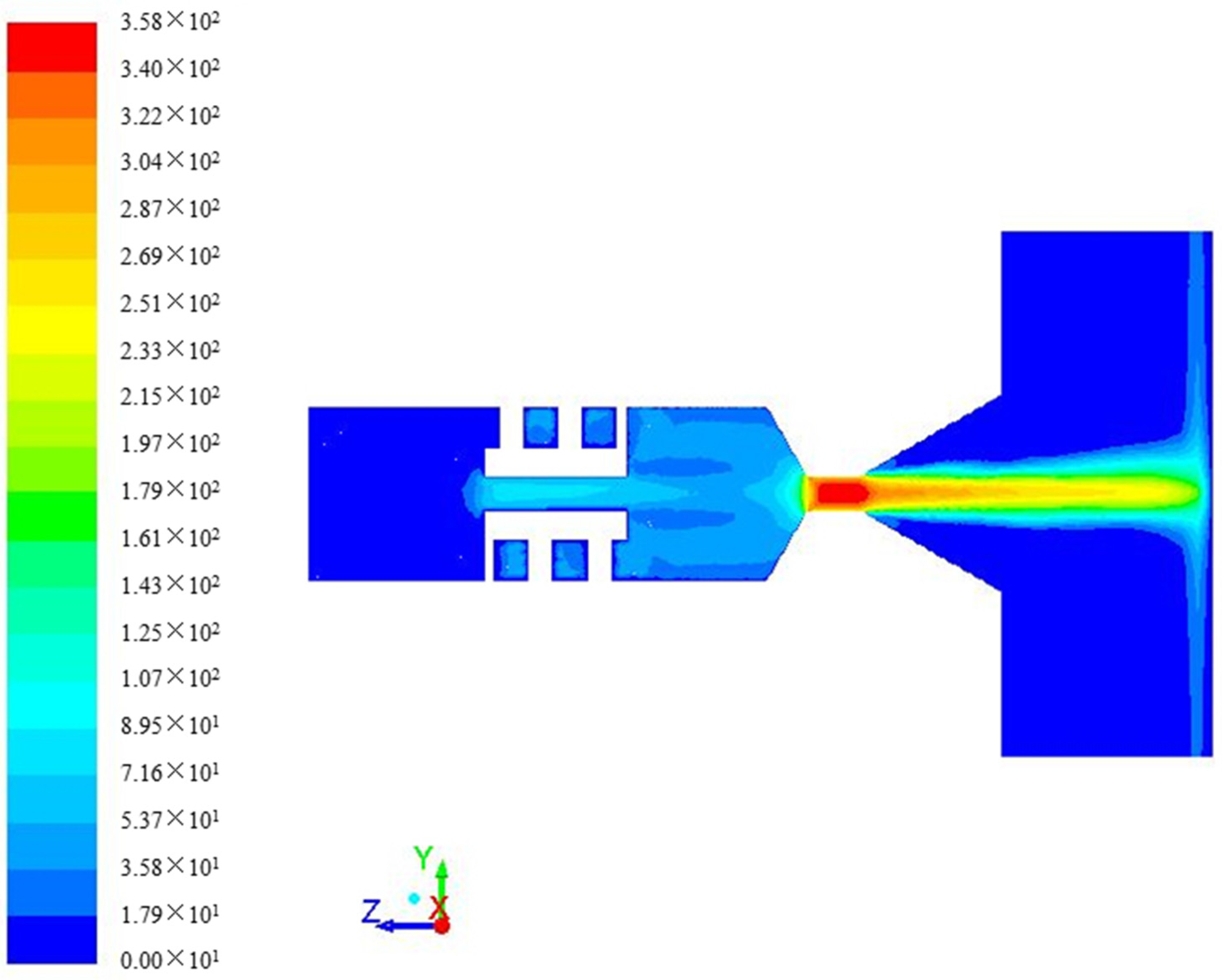

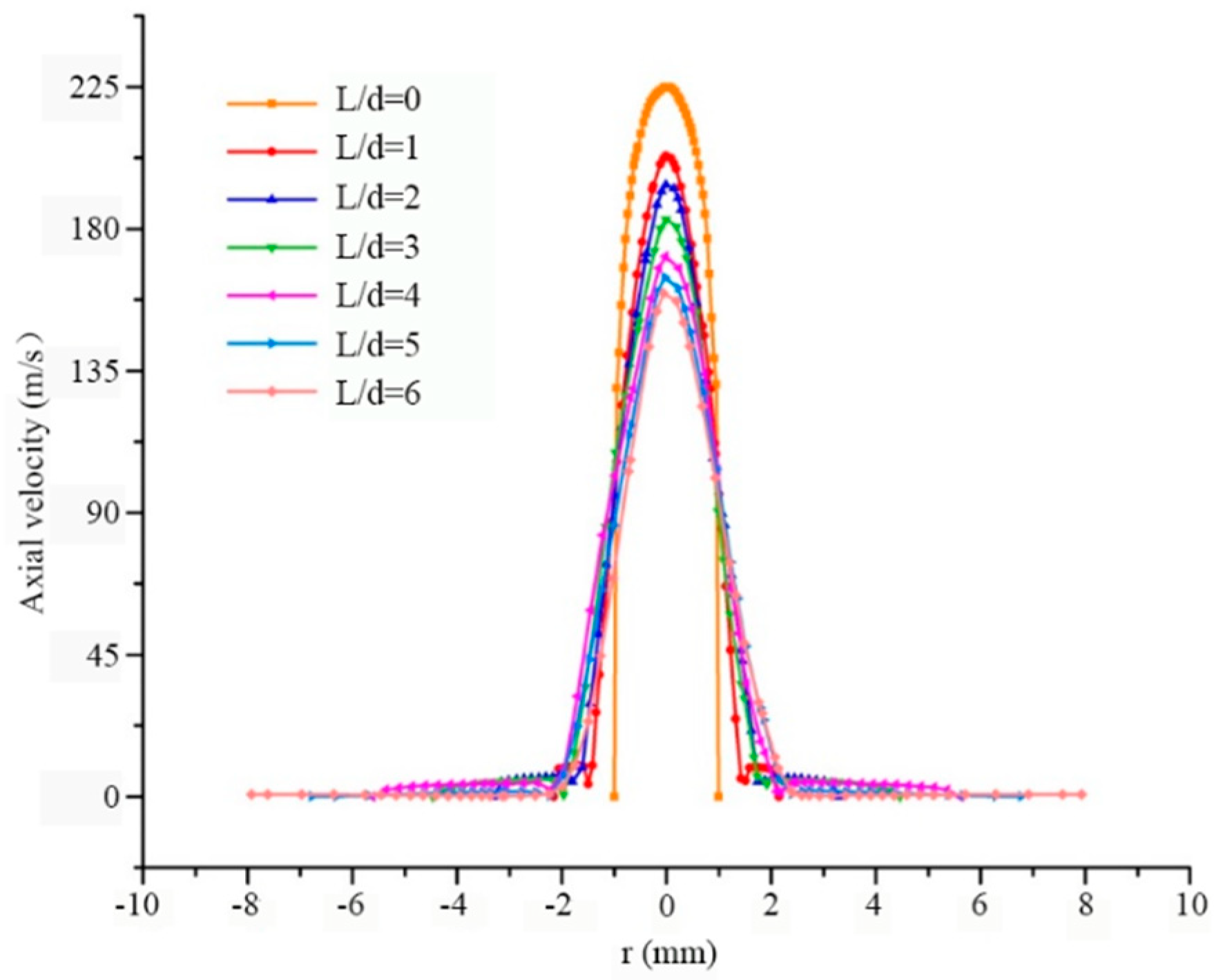
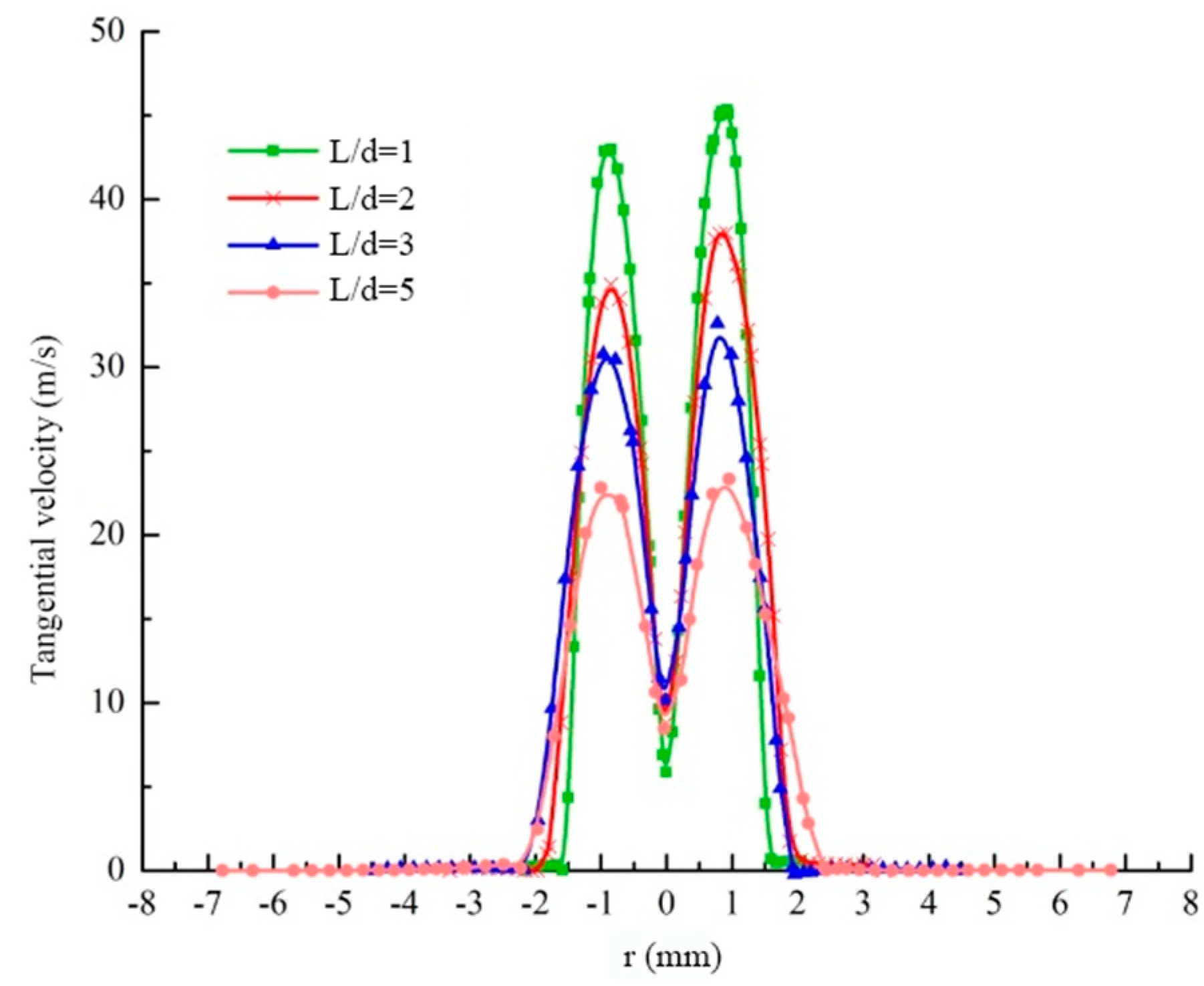
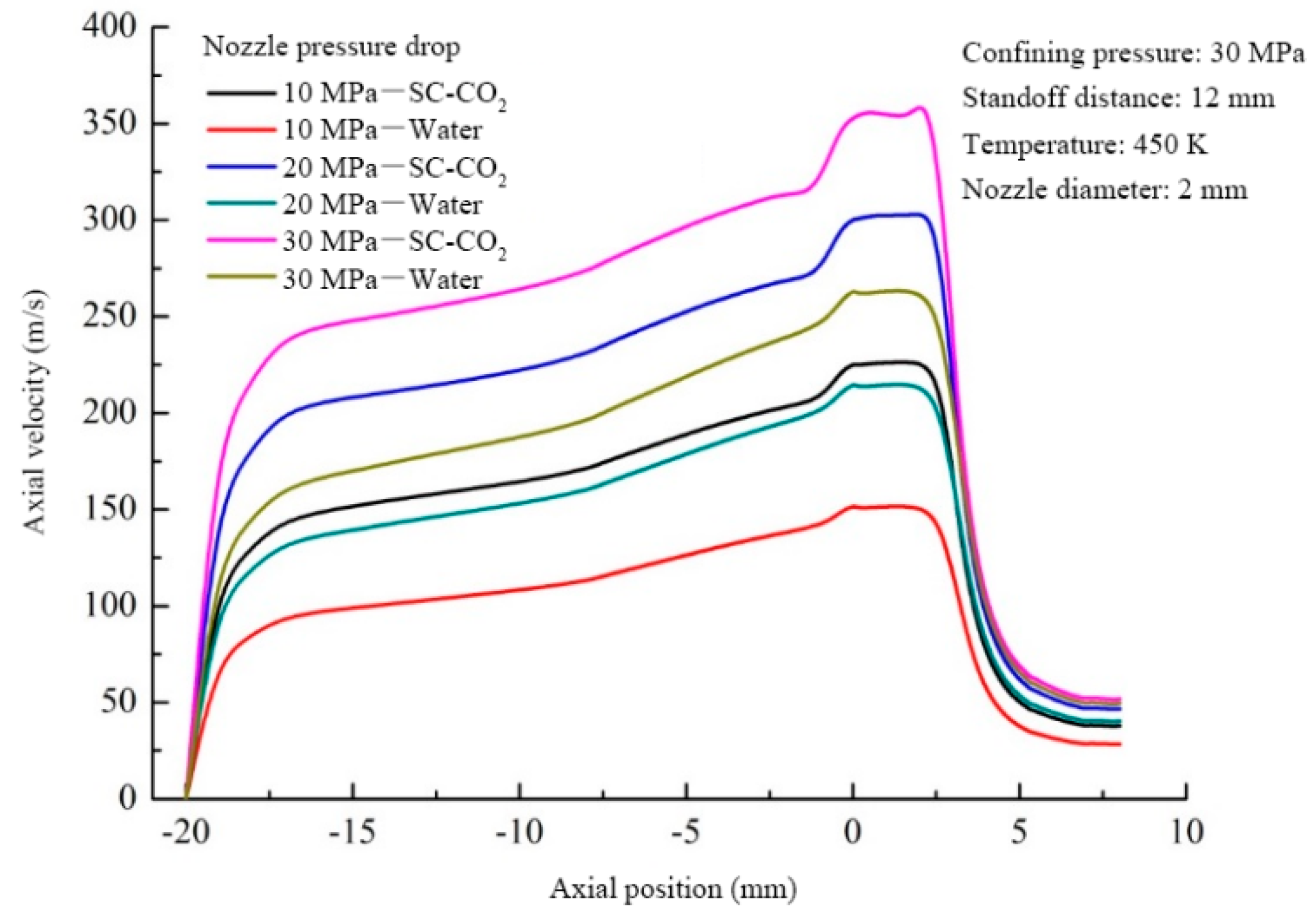
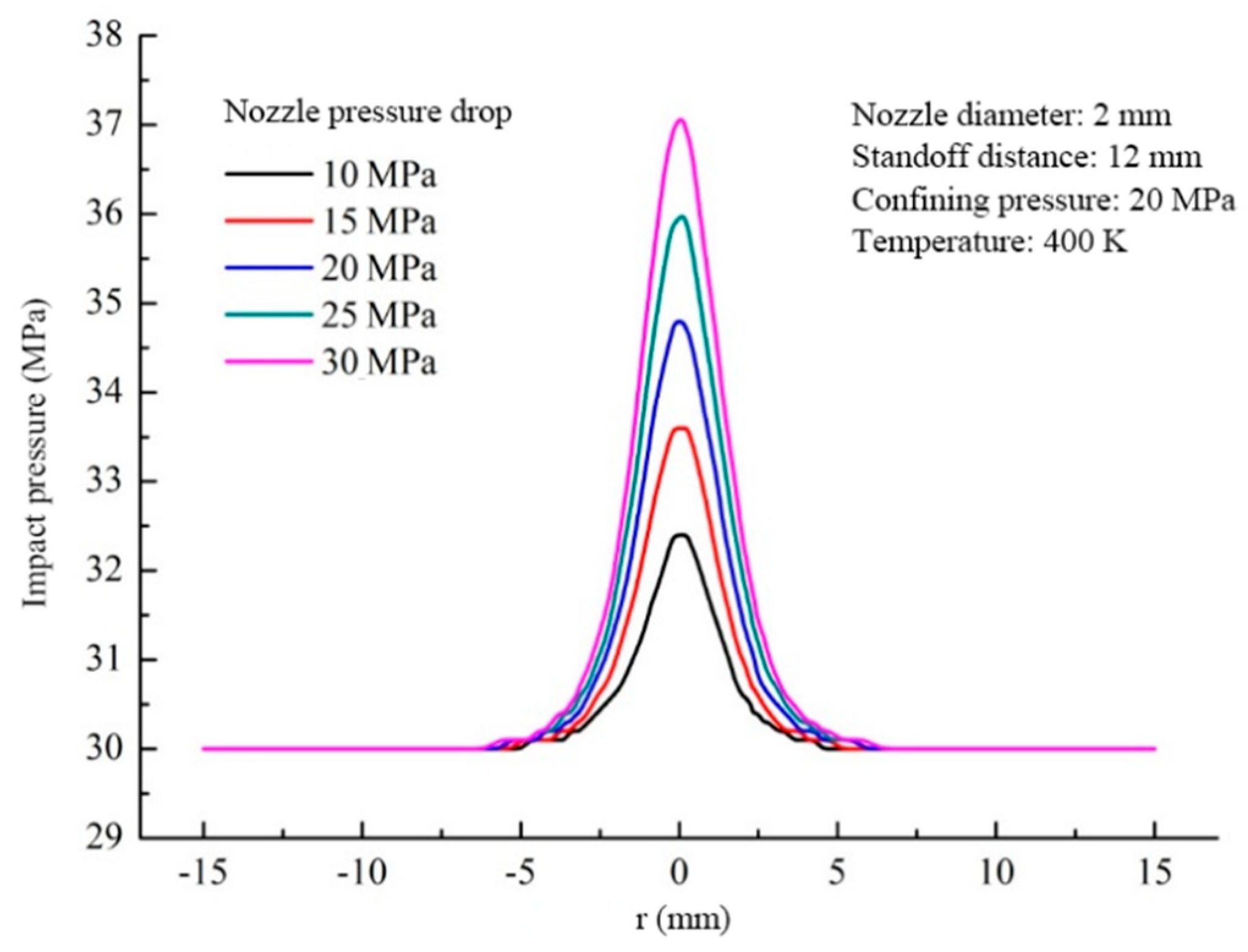

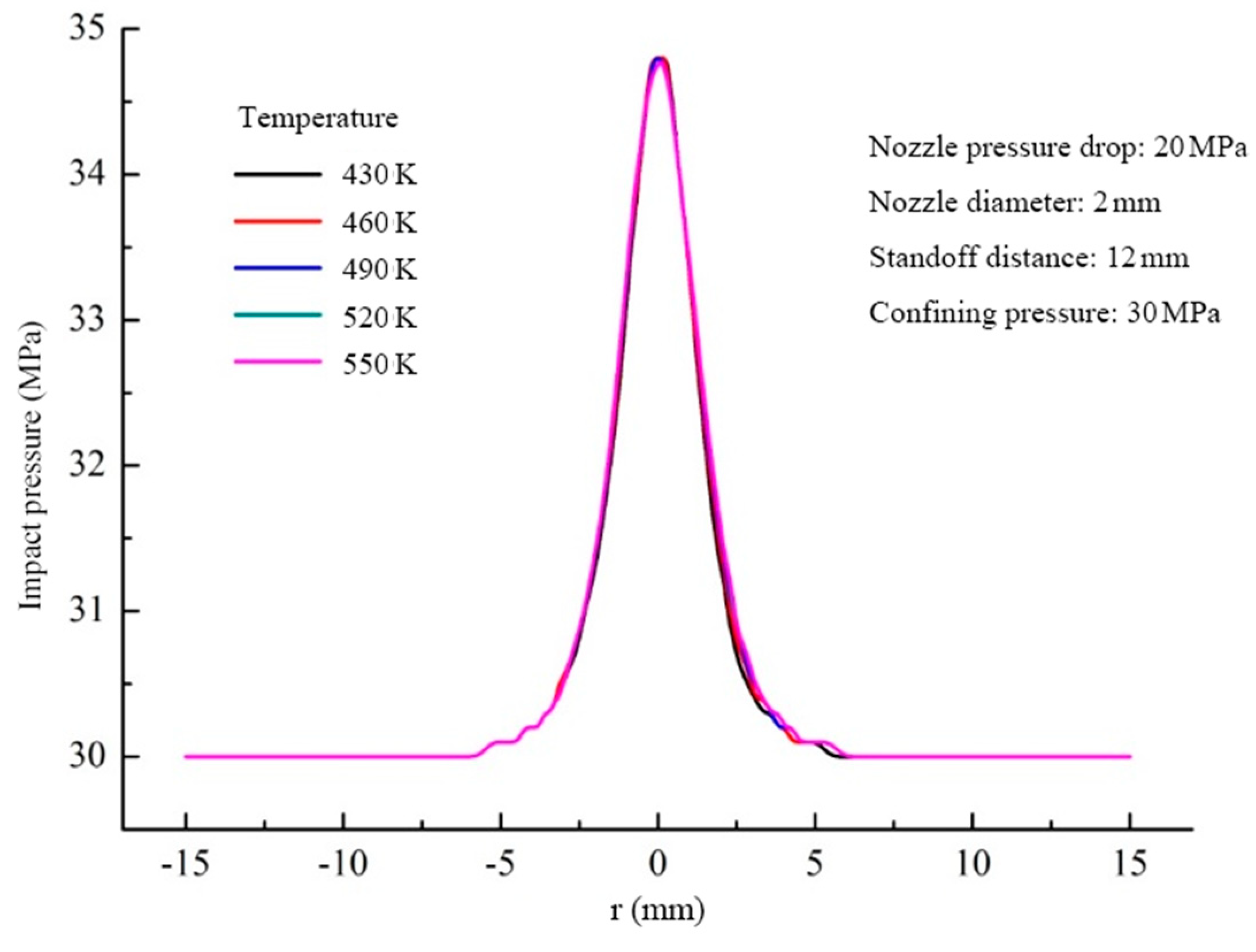
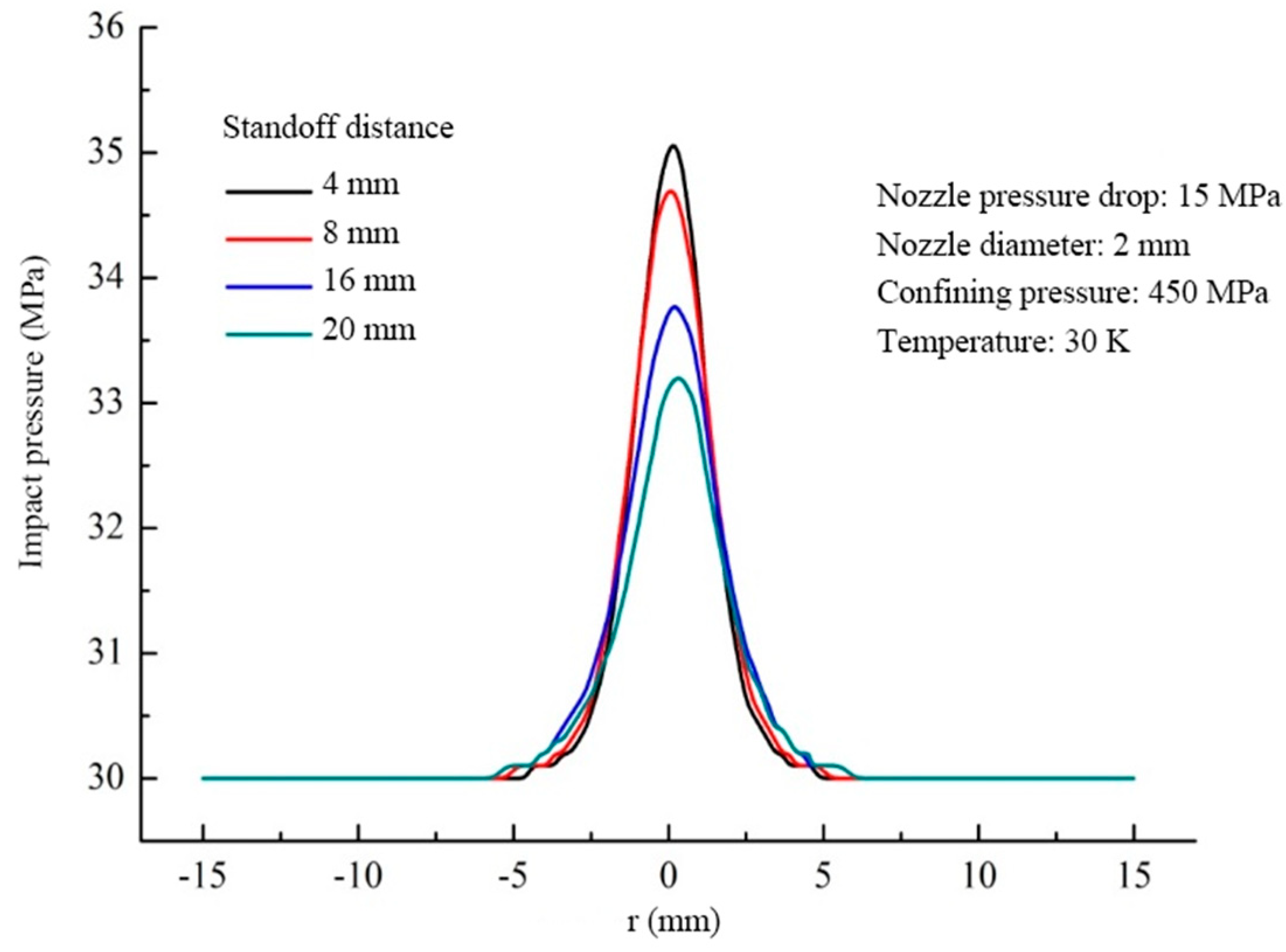

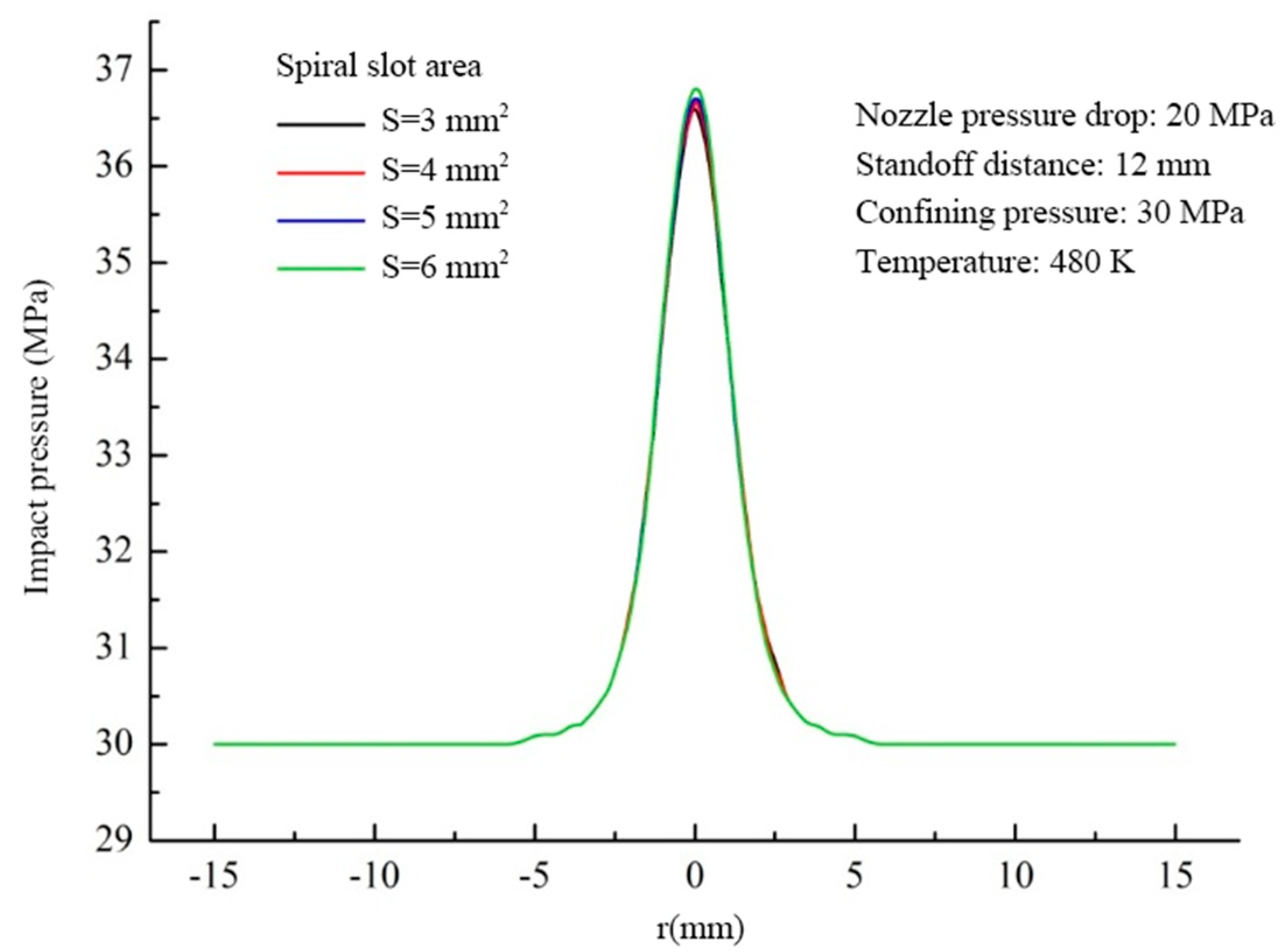
| Parameters | Values | Parameters | Values |
|---|---|---|---|
| Center hole diameter of impeller, mm | 2 | Tapper angle of the lengthened section, ° | 120 |
| Grooving area of impeller, mm2 | 4 | Inlet diameter, mm | 10 |
| Number of grovings | 3 | Outlet diameter, mm | 2 |
| Length of impeller, mm | 10 | Inlet pressure, MPa | 40 |
| Length of mixed section, mm | 8 | Outlet pressure, MPa | 30 |
| Convergence angle, ° | 60 | Inlet temperature, K | 400 |
| Length of the lengthened section, mm | 6 | Outlet temperature, K | 400 |
Publisher’s Note: MDPI stays neutral with regard to jurisdictional claims in published maps and institutional affiliations. |
© 2020 by the authors. Licensee MDPI, Basel, Switzerland. This article is an open access article distributed under the terms and conditions of the Creative Commons Attribution (CC BY) license (http://creativecommons.org/licenses/by/4.0/).
Share and Cite
Yang, Y.; Liu, H.; Mao, W.; Song, Z.; Wang, H. Study on the Impact Pressure of Swirling-Round Supercritical CO2 Jet Flow and Its Influencing Factors. Energies 2021, 14, 106. https://doi.org/10.3390/en14010106
Yang Y, Liu H, Mao W, Song Z, Wang H. Study on the Impact Pressure of Swirling-Round Supercritical CO2 Jet Flow and Its Influencing Factors. Energies. 2021; 14(1):106. https://doi.org/10.3390/en14010106
Chicago/Turabian StyleYang, Yulong, Han Liu, Weixuan Mao, Zhaojie Song, and Haizhu Wang. 2021. "Study on the Impact Pressure of Swirling-Round Supercritical CO2 Jet Flow and Its Influencing Factors" Energies 14, no. 1: 106. https://doi.org/10.3390/en14010106




